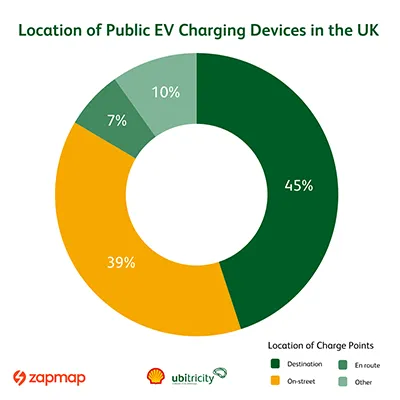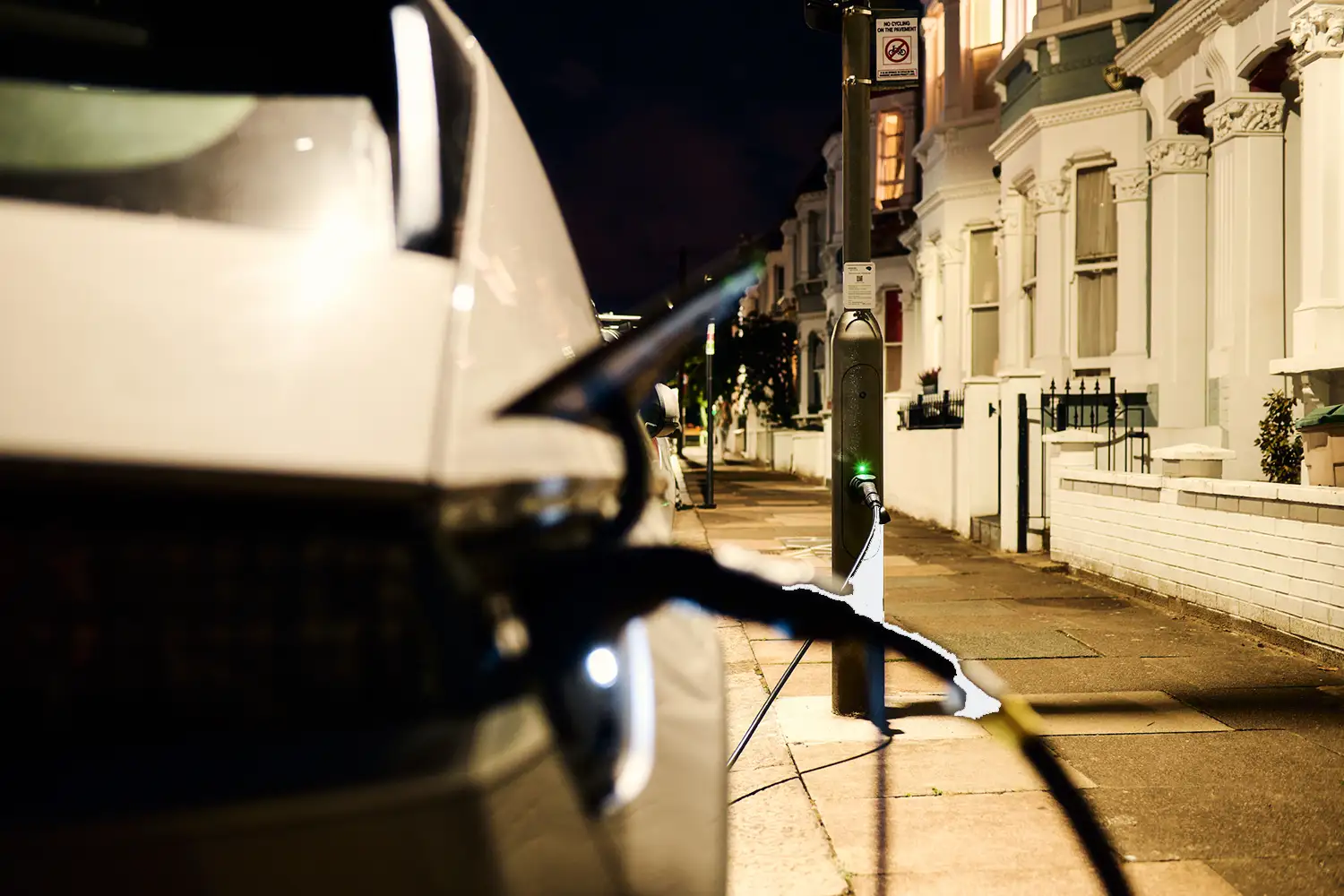We want to make sure we can help local authorities deliver the best charging infrastructure to their residents, and with nearly a million of fully electric cars on the road in 2024, and a total of 1,560,000 plug-in cars in the UK [1], the pressure for public EV charging infrastructure is growing.
For councils providing public EV charging infrastructure, the question of charger placement is one of the most important things to establish early on. We have noticed, through the many tenders we have seen, that most Local Authorities take car parks as their first step towards EV charging. On the surface, it may seem that placing public EV charge points in council owned car parks is a great solution to provide reliable and efficient charging to local EV drivers, they may think that EV chargers will be easier to install in a car park than on a residential street. This is a popular topic in our exchanges with councils over the past few years and but having worked with more than 30 Local Authorities to install over 8,000 on-street chargers in the UK, we at ubitricity, think that on-street charging should be your first priority.
Below, we have listed some crucial keys to understand why on-street charging needs to be a priority for councils.
There aren’t enough on-street EV chargers to support divers without home charging
As of January 2024, there are over 53,000 public charging devices in the UK – 45% of those are ‘destination’ chargers, meaning that they are located at the end of an EV journey or where a driver might usually stop for an extended period of time. However, only 3% of these devices are on-street chargers located on residential streets, which means that there aren’t enough on-street charging solutions for EV drivers, compared to destination charging such as car parks [2]. It is currently estimated that there are over 8 million homes in the UK unable to charge their car at home, making on-street charging a priority to deliver an efficient charging infrastructure.

People want to charge at or near home
In December 2023, a study led by ZapMap found out that on-street lamppost charging is the most sought-after location to charge for EV drivers who don’t own a home charger, with over 25% of respondents opting for this solution. Nearly 50% of respondents said they used a 3-pin plug if they don’t have a home charger, which can only work for residents with off-street parking. EV drivers crave convenience and want to be able to charge close to their homes [3], as we have found talking with our customers.
“I have a few ubitricity charge points around my home. One in front of my house, another is 2 minutes away and maybe 3 minutes for the one that is the furthest – so not very far. But the other two are far away enough that having to go out on a cold night is annoying […]. This is also a security risk with the car being a little further away from the house than I’d like.” – Hackney resident
EV charging needs to be convenient to encourage the switch to EVs
Charging must be convenient, or users won’t migrate to EV. To those considering purchasing an EV, charging behaviour is seen as starkly different to current driving, parking, and refuelling behaviour. The Britain Thinks survey launched in 2022 alongside the Government’s UK electric vehicle infrastructure strategy showed that, when it comes to EV charging, residents charging habits rarely deviate from their existing driving and parking habits [4]. For EV’s to become a feasible option for those looking to make the switch, charging would need to mirror existing driving and parking behaviours.
Resident engagement is key and does not need to be difficult
It’s important that local residents are accepting of charge point infrastructure before installation begins. Charge point operators can support local authorities through this step. As part of our project management services, ubitricity will manage resident enagagement and required planning notices. We believe that the resident engagement process is an important element of the new EV charging infrastructure awareness campaign, making them aware of their local EV charge points and encouraging usage. We also fully acknowledge that resident engagement campaigns can seem daunting but we’re here to help Local Authorities through the process, setting up clear guidelines beforehand of how objections will be assessed and how the process will be managed. In the past 6 months, we have worked with councils on over 1400 resident engagements, all of which led to successful EV charging rollouts[5].

On-street charging allows Local Authorities to get the best value for money
According to the latest EV Strategy report from the House of Lords, “Lower-powered, on-street AC charging involves cheaper installation for operators, less demand on the grid, and cheaper prices for consumers. Ensuring that the rollout of on-street charging proceeds rapidly, while taking account of broader issues such as pavement access and safety, is essential to provide fair and equitable access to charging across the UK” [6].
On-street charge points with a power output of 5kW, like ubitricity lampposts and bollards, target the long idle dwell times of cars from the moment a driver parks their car in the evening until the next morning. Drivers can plug their cars in the evening and be confident their cars will be fully charged by the next morning.
Whilst service stations or car parks only used for short stays should include rapid chargers, the dwell time is much longer for residential parking. It would be a waste of resources and energy to provide residents with rapid charging in under two hours when they usually stay parked for 8+ hours. These charge points provide fantastic value for money due to their low cost of purchase and installation. They’re also cheaper and easier to relocate if utilisation rates are low or the street landscape is changing. We have written in more details about how Local Authorities can get the best value for money when designing their EV Charging Infrastructure strategy, including costs comparison between the different types of charge points.
On-street charging is the Government’s priority
The government is making on-street charging a priority with grants like the On-Street Residential charge point Scheme (ORCS), which provides funding for local authorities to improve the availability of local EV charging infrastructure for residents without off-street (private) parking. Through ORCS funding, local authorities can receive a grant covering up to 50% of residential charge point procurement and installation costs. Charge point operators like ubitricity can cover the remaining 50%.
Another scheme available for local authorities is the Local Electric Vehicle Infrastructure fund (LEVI), which builds on the existing ORCS scheme. Its main goal is to provide public EV charging for residents who don’t have access to private parking, with low power (<22kW) CPs being the focus and must form the majority of the funding. The LEVI fund has £343m capital funding available, which emphasises the government’s strategy to prioritise slow, on-street charging.
If you’re not sure how your EV charging strategy fits within these different funds available, or if you would like to know more about how on-street charging can find your EV charging infrastructure, get in touch with our expert team and we’ll be happy to guide you throughout the process.
References
[1] How many EVs are there in the UK – EV market statistics 2024 – Zapmap (zap-map.com)
[2] ZapMap EV Charging Survey, conducted in December 2023 on 4,282 UK respondents with a tier indicating their prefer on-street charging.
[3] ZapMap EV Charging Survey, conducted in December 2023 on 4,282 UK respondents
[4] UK electric vehicle infrastructure strategy – GOV.UK (www.gov.uk)
[5] Details of numbers: 1,307 resident engagements in Richmond & Wandsworth, 35 in North Lincolnshire, and 97 in Bexley

